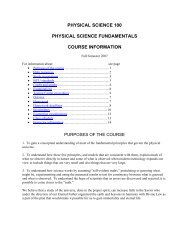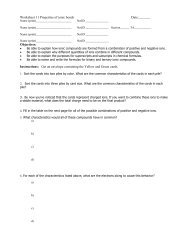knowledge, science, and the universe chapter 1 - Physical Science ...
knowledge, science, and the universe chapter 1 - Physical Science ...
knowledge, science, and the universe chapter 1 - Physical Science ...
You also want an ePaper? Increase the reach of your titles
YUMPU automatically turns print PDFs into web optimized ePapers that Google loves.
SECTION 2–5 The Second Law of Motion 23<br />
STANDARDS OF MEASUREMENT<br />
As we have already noted in this <strong>chapter</strong>, mass is <strong>the</strong> property of objects that determines<br />
how much <strong>the</strong>y accelerate in response to a force. To be useful, <strong>the</strong> concept of mass must<br />
be made quantitative. To shop for dinner we need to know, for example, whe<strong>the</strong>r a sack of<br />
potatoes has a mass of one kilogram or two kilograms. Quantities of mass are defined by<br />
comparison to a st<strong>and</strong>ard. The st<strong>and</strong>ard measurement of one kilogram has been decreed<br />
to be <strong>the</strong> mass of a specific piece of platinum- iridium which is kept under <strong>the</strong> watchful care<br />
of <strong>the</strong> Bureau Internationals des Poids et Measures at Sevres, near Paris, France. To know if<br />
you have one kilogram of potatoes, you must directly or indirectly compare <strong>the</strong> mass of your<br />
potatoes with <strong>the</strong> mass of this piece of metal.<br />
Obviously, nei<strong>the</strong>r you nor your grocer are going to take that sack of potatoes to France<br />
to make sure you’re getting exactly one kilogram of spuds. To make weighing objects against<br />
st<strong>and</strong>ards both exact <strong>and</strong> practical, copies of <strong>the</strong> st<strong>and</strong>ard kilogram are supplied to<br />
government bureaus of st<strong>and</strong>ards around <strong>the</strong> world. Those bureaus, in turn, make exactweight<br />
copies—some of which are split in halves, quarters, etc.—to distribute to manufacturers<br />
who make <strong>and</strong> sell commercial copies. You may have seen a box of “weights” in a chemistry<br />
laboratory that is <strong>the</strong> result of this process.<br />
One way to find <strong>the</strong> mass of your potatoes is to balance <strong>the</strong>m against known weights.<br />
Put your potatoes on one side of a scale <strong>and</strong> add st<strong>and</strong>ard masses to <strong>the</strong> o<strong>the</strong>r until both<br />
sides balance. The sum of <strong>the</strong> st<strong>and</strong>ard masses used equals <strong>the</strong> mass of <strong>the</strong> potatoes. You<br />
have made your comparison accurately but indirectly with <strong>the</strong> st<strong>and</strong>ard kilogram secured<br />
in a bell jar near Paris.<br />
Length <strong>and</strong> time must also be given quantitative meaning by comparison to st<strong>and</strong>ards.<br />
For many years <strong>the</strong> st<strong>and</strong>ard meter was <strong>the</strong> official measurement of a long bar of metal kept<br />
with <strong>the</strong> st<strong>and</strong>ard kilogram in France. Improved technology now allows us to define it as how<br />
far light travels in a vacuum in 1/299,792,458 seconds.<br />
St<strong>and</strong>ard kilogram<br />
The unit of mass, <strong>the</strong> kilogram (kg),<br />
remains <strong>the</strong> only base unit in <strong>the</strong><br />
International System of Units that is<br />
still defined in terms of a physical<br />
artifact. The st<strong>and</strong>ard was manufactured<br />
in 1879. It is stored in an<br />
evacuated chamber near Paris.<br />
The ancient measure of time was <strong>the</strong> sun’s position in <strong>the</strong> sky. The invention of clocks allowed greater accuracy, <strong>and</strong> was<br />
soon followed by <strong>the</strong> “invention” of <strong>the</strong> “second,” defined as 1/84,600th of a day. Today we have more precise st<strong>and</strong>ards of<br />
time based atomic vibrations. One second is defined as 9,192,631,770 vibrations of a Cesium 133 atom.<br />
Newton summarized <strong>the</strong>se various features<br />
about force, mass, <strong>and</strong> acceleration in a simple<br />
equation, termed Newton’s Second Law of<br />
Motion:<br />
Force = mass ¥ acceleration<br />
or just<br />
F = ma<br />
Alternatively, we may write it as<br />
a = F/m<br />
The second way of writing <strong>the</strong> Second Law<br />
more clearly shows that <strong>the</strong> acceleration of an<br />
object is directly proportional to <strong>the</strong> (net) force<br />
on it <strong>and</strong> inversely proportional to its mass. If<br />
you double <strong>the</strong> force on an object without<br />
changing its mass, <strong>the</strong> acceleration doubles. It<br />
you have two objects, <strong>the</strong> first of which has<br />
twice <strong>the</strong> mass of <strong>the</strong> second, <strong>and</strong> <strong>the</strong> same<br />
force is applied to both of <strong>the</strong>m, <strong>the</strong> first will<br />
accelerate at half <strong>the</strong> rate of <strong>the</strong> second. Can<br />
you see how this is described by <strong>the</strong> Second<br />
Law<br />
Suppose an object has a mass of 100 kilograms.<br />
If it is pushed by a force that causes it<br />
to accelerate at a rate of 5 meters per second<br />
every second, <strong>the</strong>n <strong>the</strong> Second Law tells us that<br />
<strong>the</strong> force is 100 ¥ 5 = 500 newtons. If <strong>the</strong><br />
object was originally at rest, <strong>and</strong> this force was<br />
in effect for 10 seconds, <strong>the</strong> object will emerge<br />
with a velocity of 50 meters per second.<br />
We note that <strong>the</strong> First Law is a special case<br />
of <strong>the</strong> Second Law. It is <strong>the</strong> case in which no<br />
forces act on <strong>the</strong> object, allowing it to remain<br />
in uniform motion. The First Law may also be<br />
considered as a qualitative statement about<br />
motion <strong>and</strong> <strong>the</strong> presence or absence of force.<br />
The Second Law is quantitative. It says exactly<br />
how much <strong>the</strong> motion of an object of mass “m”<br />
changes when acted on by a force of magnitude<br />
“F.”<br />
The significance of <strong>the</strong> Second Law cannot<br />
be overstated. It was <strong>the</strong> first universal principle<br />
discovered that enabled changes observed<br />
in our physical world to be described in ma<strong>the</strong>matical<br />
terms.






